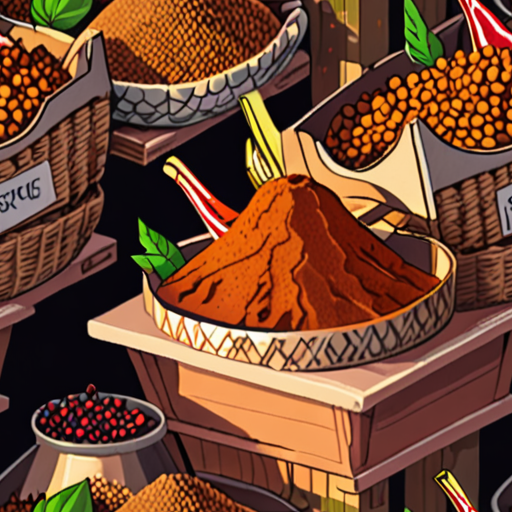Exploring the world of culinary delights, one of the most fascinating aspects of cooking lies in the art of combining spices to unlock a symphony of flavors. From classic pairings to innovative blends, understanding how different spices interact with each other can elevate even the simplest dishes into gastronomic masterpieces. Whether you’re a seasoned chef or an enthusiastic home cook, mastering the technique of spice pairing can open doors to new recipe possibilities and take your cooking to the next level.

Spice Pairing Guide
We’re excited to share our expertise on spice pairing, helping you elevate your cooking game and discover new flavors.
- Cumin and Coriander: These earthy spices complement each other beautifully, often used in Middle Eastern and Indian cuisine.
- Paprika and Garlic: A classic combination found in many Hungarian dishes, adding a smoky depth to your meals.
- Ginger and Chili: Spicy and invigorating, commonly used in Asian-inspired recipes to add heat and warmth.
- Lemon Pepper and Rosemary: Brighten up your dishes with this refreshing and herbaceous duo, perfect for Mediterranean-style cooking.
- Cinnamon and Nutmeg: Warm and aromatic, these spices work wonders together in sweet and savory baked goods.
Exploring Global Flavors
From the bold flavors of Korean chili flakes to the subtle nuances of Japanese matcha, we’ll delve into the world of international spices and explore how to combine them effectively.
- Korean Gochujang and Soy Sauce: Add depth and umami to your marinades and sauces with this dynamic duo.
- Indian Turmeric and Cumin: Create a vibrant and aromatic curry paste with these two essential spices.
- Mexican Chili Powder and Lime Juice: Infuse your tacos and grilled meats with the zesty flavors of Mexico.
- Thai Fish Sauce and Galangal: Unlock the secrets of Thai cuisine with this pungent and aromatic combination.
Tips for Mastering Spice Pairing
To become a spice pairing master, remember:
- Balance flavors: Combine complementary spices to create harmony in your dishes.
- Experiment with ratios: Find the perfect balance between spices to suit your taste preferences.
- Consider the cuisine: Understand the traditional spice combinations used in various global cuisines.
- Don’t be afraid to try new combinations: Spice pairing is an art, and there’s always room for innovation!
Flavors That Go Well With Spicy
We understand that pairing the right flavors with spicy foods can elevate the overall taste experience.
- Chocolate: Dark chocolate, with its robust and slightly bitter taste, complements spicy flavors exceptionally well. Its intense cocoa flavor can stand up to the heat and enhance the overall taste experience.
- Milk Chocolate: Milk chocolate, with its sweeter and creamier profile, creates interesting contrasts with spiciness.
- Fruit: Certain fruits like pineapple, mango, and papaya have a sweet and tangy flavor that pairs well with spicy dishes.
- Creamy Cheeses: Soft cheeses like brie, feta, and goat cheese can help balance out the heat of spicy foods.
- Nuts: Crunchy nuts like almonds, cashews, and pistachios can provide a satisfying contrast to the smoothness of spicy sauces.
- Herbs and Spices: Fresh herbs like cilantro, basil, and mint can add a cooling effect to spicy dishes, while spices like cumin, coriander, and cinnamon can enhance the overall flavor.
At Memories Restaurant, we believe that the key to pairing flavors with spicy foods is to find a balance between contrasting textures and temperatures. By combining ingredients that complement and contrast with the heat of spicy dishes, you can create a truly unforgettable culinary experience.
Popular Spicy Flavors and Their Complementary Ingredients
- Korean BBQ Sauce: Sweet and spicy Korean chili flakes called gochugaru pair well with ingredients like soy sauce, brown sugar, garlic, and ginger.
- Indian Curry: Warm spices like cumin, coriander, and turmeric complement the heat of Indian curries, which often feature ingredients like coconut milk, yogurt, and fresh herbs.
- Mexican Salsa: A combination of diced tomatoes, onions, jalapenos, cilantro, and lime juice creates a refreshing and spicy salsa that pairs well with tortilla chips or grilled meats.
Tips for Pairing Flavors with Spicy Foods
- Balance Heat with Coolness: Combine spicy ingredients with cooling elements like dairy products, herbs, or crunchy textures to balance out the heat.
- Contrast Textures: Mix smooth and creamy ingredients with crunchy or crispy elements to add depth and interest to spicy dishes.
- Experiment with Flavor Profiles: Try pairing spicy ingredients with sweet, sour, salty, or umami flavors to create unique and exciting combinations.

Popular Spice Blends
We’re proud to share our favorite global spice blends that elevate any dish.
- Baharat – A Middle Eastern blend of spices including cumin, coriander, cinnamon, cardamom, cloves, and black pepper.
- Ras el hanout – A Moroccan blend of ground spices including cumin, coriander, cinnamon, ginger, turmeric, and rose petals.
- Garam masala – An Indian blend of ground spices including cloves, cardamom, cinnamon, black pepper, and nutmeg.
- Chili powder – A spicy blend of chili peppers, garlic, cumin, oregano, and paprika commonly used in Mexican and Southwestern cuisine.
- Curry powder – A blend of ground spices including turmeric, coriander, cumin, cinnamon, cardamom, and red pepper commonly used in Indian and Southeast Asian cuisine.
- Adobo seasoning – A Latin American blend of spices including garlic, oregano, cumin, coriander, and chili peppers.
- Chinese five-spice – A blend of ground spices including cinnamon, cloves, fennel seeds, star anise, and Szechuan peppercorns commonly used in Chinese cooking.
- Italian seasoning – A blend of herbs including basil, oregano, thyme, rosemary, and sage commonly used in Italian cooking.
- Cajun seasoning – A spicy blend of spices including paprika, garlic, onion, cayenne pepper, and thyme commonly used in Louisiana-style cooking.
- Jerk seasoning – A Caribbean blend of spices including allspice, thyme, scotch bonnet peppers, nutmeg, and cinnamon commonly used in Jamaican cooking.
These spice blends can add depth and complexity to a variety of dishes, from soups and stews to roasted meats and vegetables.
At Memories Restaurant, we love experimenting with different spice blends to create unique and delicious flavors.
Try incorporating these spice blends into your cooking and discover new flavors!

What Does Allspice Pair Well With?
Allspice is a versatile spice that can elevate various dishes, from savory meals to sweet treats.
- Poultry: Allspice pairs exceptionally well with chicken, turkey, and duck, adding warmth and depth to roasted or grilled meats.
- Game Meats: Its robust flavor complements venison, elk, and wild boar, making it a popular choice for game meat recipes.
- Seafood: Allspice enhances the flavors of fish, shrimp, and scallops, particularly when combined with citrus and herbs.
- Root Vegetables: Carrots, parsnips, and turnips benefit from allspice’s warm, aromatic flavor, especially when roasted or mashed.
- Cabbage and Onions: Sauteed or braised with allspice, these vegetables develop a rich, comforting flavor profile.
- Fruits: Apples, pears, and yams are all excellent matches for allspice, which adds a sweet, spicy flavor to baked goods and desserts.
- Nuts: Allspice pairs nicely with almonds, walnuts, and pecans, making it a great addition to nut-based baked goods and snacks.
- Dark Chocolate: The combination of allspice and dark chocolate creates a decadent, complex flavor experience perfect for special occasions.
In addition to these classic pairings, feel free to experiment with allspice in your own recipes and discover its unique potential.
Exploring Allspice’s Flavor Profile
Allspice has a warm, slightly sweet, and spicy flavor, often described as a combination of cinnamon, nutmeg, and cloves.
Tips for Using Allspice
To get the most out of allspice, use it in moderation, as its strong flavor can overpower other ingredients.
Grind whole allspice berries just before using to release their full aroma and flavor.
Combine allspice with other spices, herbs, and citrus to create unique blends and flavor profiles.
What Flavor Does Allspice Add?
Allspice is a multifaceted spice that adds warmth and depth to various dishes.
- Cloves
- Nutmeg
- Star Anise
- Fennel
- Black Pepper
- Cinnamon
The unique combination of these flavors creates a complex and aromatic taste experience.
Exploring the Flavors of Allspice
When used in cooking, allspice can evoke feelings of comfort and nostalgia due to its warm, spicy, and slightly sweet undertones.
- Warmth: Allspice contains compounds that give off a warm, comforting sensation, reminiscent of cinnamon and nutmeg.
- Savory: The peppery and earthy notes in allspice add a savory element to dishes, balancing out sweetness and acidity.
- Aromatic: The fragrance of allspice is intense and inviting, making it a popular choice for baked goods, desserts, and savory dishes alike.
Using Allspice in Cooking
Allspice pairs well with a variety of ingredients, including meats, vegetables, fruits, and grains.
- Pork Chops: Rub pork chops with a mixture of allspice, brown sugar, and thyme for a delicious and aromatic glaze.
- Vegetable Dishes: Add allspice to roasted vegetables like carrots, Brussels sprouts, and sweet potatoes for added depth and warmth.
- Baked Goods: Use allspice in place of cinnamon or nutmeg in baked goods like cakes, cookies, and muffins for a unique twist.
At Memories Restaurant, we love experimenting with allspice in our recipes and encourage you to do the same!

What Does Allspice Do to Your Body?
Allspice is a spice made from the dried fruit of the Pimenta dioica tree, native to the Caribbean and Central America.
- Rich in Antioxidants:
- Allspice contains antioxidants like flavonoids, phenolic acids, and terpenes, which can help protect cells from damage caused by free radicals.
- Pain Relief Properties:
- The eugenol content in allspice has been shown to have analgesic and anti-inflammatory properties, making it effective in relieving pain and reducing inflammation.
- Muscle Relaxation:
- Allspice essential oil may promote relaxation and reduce muscle tension, making it beneficial for individuals experiencing stress and anxiety.
Benefits of Consuming Allspice
- Improves Digestion:
- Allspice has been traditionally used to aid digestion and relieve symptoms of indigestion, bloating, and gas.
- Antimicrobial Properties:
- The antimicrobial properties of allspice can help prevent the growth of bacteria and fungi, making it useful in preserving food and preventing infections.
- May Help Lower Blood Sugar:
- Some studies suggest that consuming allspice may help lower blood sugar levels and improve insulin sensitivity.
Risks and Precautions
- Allergic Reactions:
- Some individuals may be allergic to allspice, which can cause symptoms like hives, itching, and difficulty breathing.
- Interference with Medication:
- Eugenol in allspice may interact with certain medications, such as blood thinners and diabetes medications, so consult a healthcare professional before consumption.
- Pregnancy and Breastfeeding:
- As with any spice, consume allspice in moderation during pregnancy and breastfeeding, as excessive consumption may cause uterine contractions or affect milk production.
Conclusion
In conclusion, allspice offers various health benefits, including antioxidant properties, pain relief, and muscle relaxation. However, it is essential to consume allspice in moderation and be aware of potential risks and interactions with medication. As with any spice, consult a healthcare professional before adding allspice to your diet, especially if you have underlying medical conditions or allergies. By incorporating allspice into your meals and snacks, you can enjoy its unique flavor and aroma while reaping its potential health benefits.

0 Comments